SPACEX AND GOLDEN ASTRONAUT PRICES
Ready for some confusing numbers? (1) Well, get a cup of strong black coffee, and see if you can follow the following...
Spacex prices
To start off with, we have to get to grips with the
pre-decimal Pound Sterling. When Spacex was new, this convoluted currency
system (2) was still very much
in use. Basically, £1 was equal to 20 shillings, each of which were equal
to 12 pence. Meaning there were 240 pennies to each Pound. To help clarify
matters, price notation varied between using abbreviations of Roman origin (£sd for Librae, sestertii, denarii)
or a quick bit of punctuation, while shillings were generally left unspoken. :)
To give some examples, a price tag could read £2 12s 6d
("two Pounds, twelve and sixpence") or 8/3 ("eight and thruppence") or 6/-
("six bob" meaning six shillings) or 1/2d ("a ha'penny" and not one shilling
and tuppence :).
When it came to pricing, British salesmen often used two tricks to downplay an item's price. In decimal currencies, we often see a price of, say, $4.99 (often written with a big 4 and a small 99) to make an item seem cheaper than the almost $5 it really costs. In pre-decimal Sterling, one would price something at, say, 4/11 or 4s 11d for exactly the same reason, being one penny less than a full 5/- or 5s (both meaning five shillings remember? :)
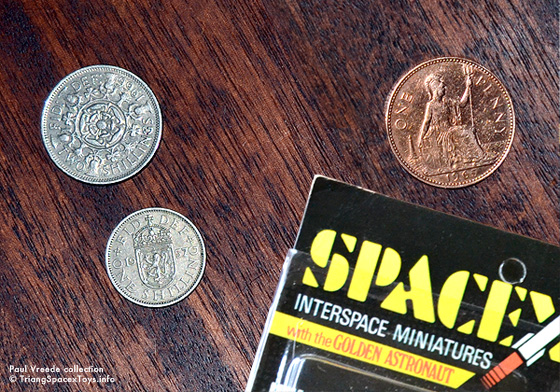
Priced at 2/11, you would hand over 3/- for a Spacex card and get a penny as change.
The other trick was to not use Pounds in a price, but just use shillings and pennies. The psychology behind this was that a single Pound represented quite a bit of money in those days, so a price using Pounds "looked" more expensive. This is why a Spacex Superset 1 would be priced at 55/- instead of £2 15s (worth exactly the same) to make it seem more affordable to the average person's buying budget.
In the prices below, I've converted this whole rigmarole to "decimal" pennies (by calculating all the small change from base-240 to base-100) so it's easier to compare to today's prices. I've also used an online retail price index calculator (3) to have an idea of what those prices would equate to today.

Each Spacex vehicle on card cost 2s 11d, which is 14.6 pence decimal. In today's money that would be worth £1.75 or so.
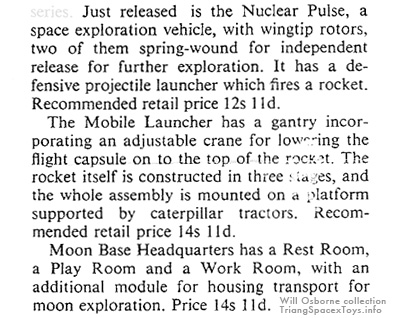
The Nuclear Pulse sold for 12s 11d, which amounts to 64.6 pence decimal, today worth some £7.70. The Mobile Launching Platform and Moon Base each retailed at 14s 11d, which amounts to 74.6 pence decimal, today worth some £8.85.

Spacex Superset 1 was priced at 55/- (55 shillings 0 pence), Which is £2.75 decimal, worth £32.60 in today's money. (4)
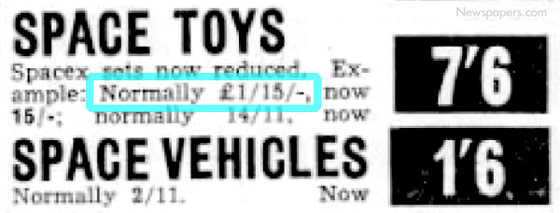
We don't have an 'official' source for the suggested retail price of the later three boxed sets, but the advert above lists 'Spacex sets' priced at £1/15/- which is a different price to anything we've seen elsewhere and at a price level that would fit the boxed sets. The other 'regular' prices in the advert are identical to SRPs found in 'official' sources shown above so I'm inclined to view these prices as realistic SRPs as well. £1/15/- equates to £1.75 decimal and would be worth some £20.75 today.(5)
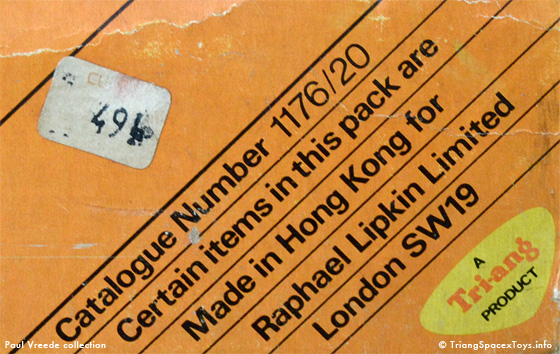
My Moon Base HQ set has a price sticker on it which Paul Woods decyphered as reading 49 1/2p (above, with the p having run into the fraction). Which, as Mike Burrows had already suggested, must be a knock-down discount price from after Sterling went decimal in February 1971. 49 1/2p in those days would be worth around £6 today.
We sadly also haven't yet found any information about suggested retail prices for the later Spacex toys produced by Pippin. One blister card has a 15p price sticker however, which is roughly half a penny more than the original SRP of Stage 1 cards (2s 11d, which equates to 14.6 pence decimal) so could well be the regular price after Sterling went decimal.

Having just converted all the original prices into today's equivalent value, it struck me that the price of Superset 1 wasn't that "modest" (as claimed above); the set actually being somewhat expensive for what it contains. Let me try to illustrate:
A single Spacex vehicle incl an astronaut on card cost 2s 11d. Which, to keep it simple, was 35d pre-decimal. Superset 1 was 55s 0d, or 660d pre-decimal, and contains 15 vehicles, 6 astronauts and a vacuformed moonscape in quite a large box with a vacuformed tray to hold all the toys.
Well, if you bought the 15 vehicles on card, you'd pay 15 x 35d = 525d. Meaning you had to pay 135d more (to get to 660d) for the (smallish) moonscape and the fancy box, and 9 astronauts less. Which is 5d short of another 4 vehicles on card, or 20d short of a Nuclear Pulse at 155d pre-decimal. Especially from today's perspective - where we expect to pay less per toy if we buy, say, 5 toy cars in a single pack as opposed to 5 individually packed cars - that is a quite expensive moonscape and gift box. No doubt also due to that big box costing a lot more to transport as well.
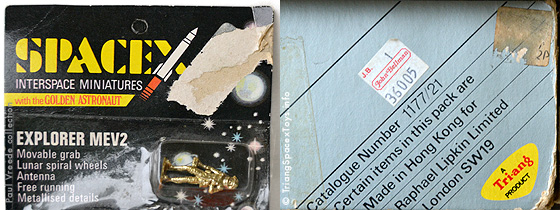
Price tags were usually removed in Europe:
I have no Spacex blister card with a remaining sticker; some used powerful adhesive.
The price at top-right on the box has also been removed, the remaining sticker will be a shop stock number.

As far as export prices for Spacex are concerned, the one above is for a single Stage 1 blister card from an advert for the Morgan department store in Montreal, Canada. (6) This was "ordinarily" priced at C$.49 (small text at top-left), though Morgan's offered a discount if you bought three vehicles together or even the entire series of fifteen.
The price below is from Lassner, which turned out to be a toy store in Luxemburg City. So that was 20 Luxemburg Francs for that blister card when it was new (converted to Euros those 20 Francs equate to just under €0.50).
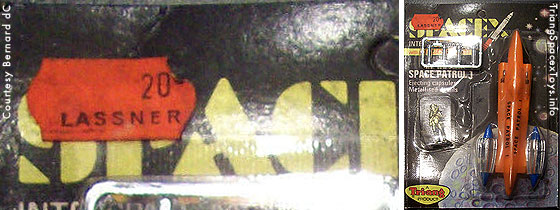
Golden Astronauts prices
Here are the original 1969-70 prices, with their values in today's money using an online consumer price index. (7)

Single vehicles on card cost 49¢ each as printed on the card, worth some $2.80 today. If a toy shop wanted a different price, it could cut off the corner of the card where the price was printed. The very earliest cards didn't have a pre-printed price so required a sticker, and some shops put one on anyway because it also listed the shop stock number and/or a discounted price.
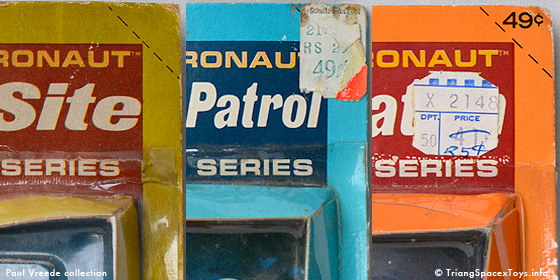
Triple cards had a suggested retail price of $1.29 in 1969, (8) amounting to around $7.50 today. However, most examples known to us are priced near or at $1 (possibly from being discounted in 1971), which would amount to around $5.85 today. Very nicely illustrating the price savings principle of buying "3 for the price of 2.5" due to saving on packaging, as opposed to the expensive deal one got when buying Spacex Superset 1 (see above).
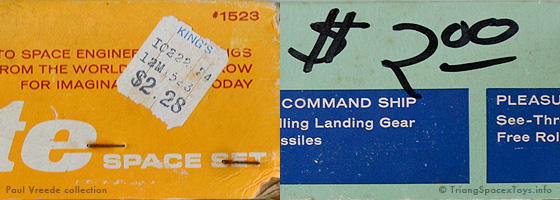
The three themed boxed sets had a suggested retail price of $3.- which is some $17.60 in today's money. But again, I have a set with a lower (probably discounted) price on it of $2.28, equivalent to some $13.30 today.
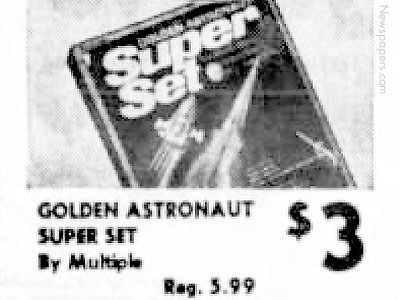
We don't have an 'official' price for the Golden Astronaut Super Set. But there is an advert (9) that shows a regular price of $5.99 which sounds realistic. That price would equate to some $35.20 today.
Mail order had the best deals in the US. $6.88
would get you 13 small vehicles plus the Mobile Launch Pad and Moon Base
from Montgomery Ward (around $40 today). That would save you $0.99 (or
12.5%) when compared to buying two boxed sets (MLP + 2 vehicles and Moon
Base + 2 vehicles) at $3 each plus three triple cards at $1.29 each as
being the cheapest alternative.
And JC Penney would sell you the entire range of three large toys and 15 small
vehicles for $8.88 (some $52 today). That would save you $3.99 compared
to 3 boxed sets (for the three large toys plus 6 smaller vehicles) at
$3 each and three triple cards for another 9 vehicles.
For both cases above, in reality you'd have to buy single vehicles instead
of cheaper triple packs to avoid duplication, but that's not the point.
The point is that you saved substantial money, especially from Penney's
who packed everything in a plain brown box that wasn't even a third the
size of Spacex Superset 1. Penney's at least saw the value of not having
to transport a large box with more air than toys in it...
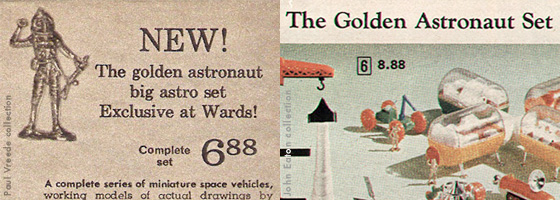
While busy on these prices, I also noticed something else. During the (justabout entire) short three years that Spacex/GA was sold, the Sterling exchange rate was fixed at £1 = $2.40 before being floated in the later half of 1971. With those particular relative values, I believe (being lousy at sums :) that made a penny and a cent equal in worth: £1 pre-decimal being 240 pence exchanging to $2.40 being 240 cents. Which means that in 1969, you would pay 35¢ in Britain for a toy costing you 49d (pre-decimal pennies) in the US. Next to a possible difference in import duties from Hong Kong to the UK and US respectively, I think the simplest explanation is that Spacex toys will only have had a mark-up from Triang (their margin on top of the price paid to the Hong Kong manufacturers), whereas Golden Astronaut toys will have had a mark-up from Miner Industries as well as from Triang.
General note: all external links open in new windows. Just close them to get back here. :)
1) If you came to this page looking for a "collector's price
guide", then I'm sorry but you won't find one here. With only a very few
exceptions (notably Koll's guides to vintage Märklin trains, and
then mainly in Germany :) these are rarely worth the paper they're printed
on. There are so many factors involved in a toy's value, that a mere listing
will do more harm than good in terms of clarity and realistic pricing.
If you want to know what a toy is truly worth, either ask an experienced,
specialist collector (preferably one who already has the toy in question
:) or take a look at finished auction prices to see what any bidders actually
paid for one, and, equally important, at what price it got left with no takers.
Another important fact to keep in mind with auction results, is that for a second, identical item there will very likely be
one bidder less, being the winner of the previous item. This can make a huge difference in the final price, since the winning bidder
has to top the maximum bid of the second-highest bidder. Without the winning bidder's intervention, the second-highest bidder
would have won the item for the maximum bid by the third-highest bidder plus one bid increment of £1 or $1 to be highest. A realistic auction result
for the second item would therefore consist of the third-highest bidder's maximum plus that £1 or $1. But in the end it'll always depend on circumstances at the moment itself, the market setting a higher or lower value, so mileage will vary. back
to text
2) If any American readers have (grand)fathers who went through the UK during World War 2, then these'll confirm that the local currency required quite a bit of getting used to. Not just because of the non-decimal system, but also by featuring exotic denominations like guineas, crowns, farthings and whatnot to keep it interesting. Having said that, my own good father spent some time working in London around 1950, and always said that there was logic in the system, which actually made calculations pretty easy once you got the hang of it. Me, I'll happily take his word for it. :) back to text
3) Online retail price index calculator for Pound Sterling at measuringworth.com, being the most relevant of several calculators there. back to text
4) 1969-70 Spacex prices from articles in Toys International trade magazine of July/August 1969 and Meccano Magazine of January 1970. Links at top of those pages return you here. back to text
5) This detail is from a 1970 press advert by Lewis's stores in Stoke-on-Trent. It's the last advert on the UK Press advert features page. Use your browser's Back button to return here. back to text
6) Since there's no calculator for Canadian Dollars at measuringworth.com I can't see what that price would be worth today. The Morgan advert is in the Consumer Advertising section. Link at top of that page returns you here. back to text
7) Online consumer price index calculator for US Dollar at measuringworth.com. back to text
8) 1969-70 GA prices from advert in Toys and Novelties trade magazine of January 1970. Link at top of that page returns you here. back to text
9) Detail from advert by S Klein in Westchester, NY. This is hte fourth advert shown on the US Press advert features page. Use your browser's Back button to return here. back to text